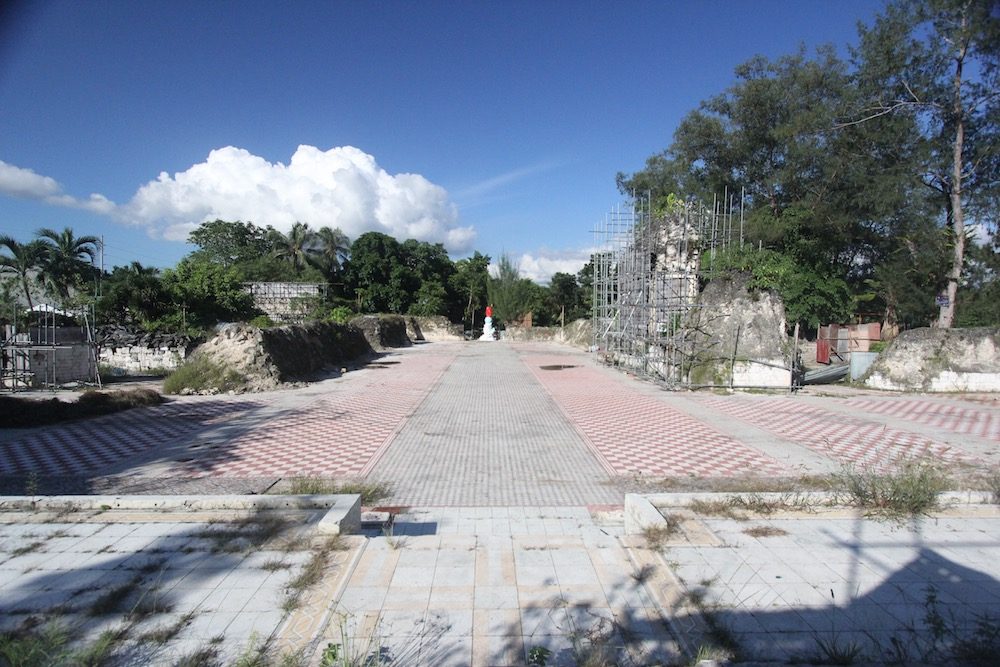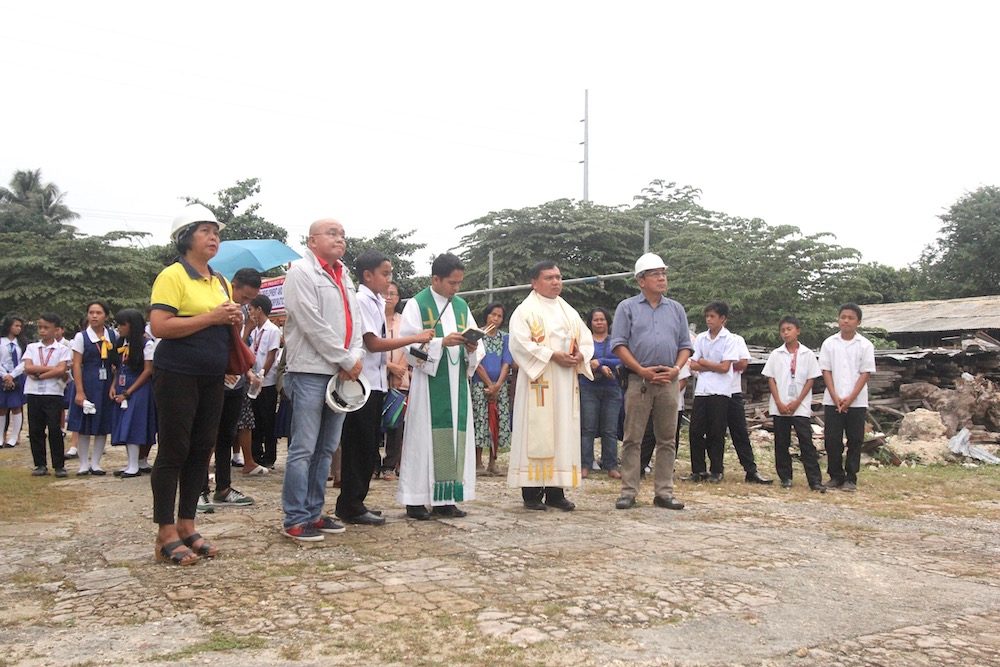SUMMARY
This is AI generated summarization, which may have errors. For context, always refer to the full article.

BOHOL, Philippines – Basilica Regañon, a resident of the town of Loon, remembers October 15, 2013 very well. She went to the 7 am mass, attended a lecture, and was home, sweeping, when the 7.2-magnitude earthquake struck.
“It was 8:33 in the morning. Doon ko nakita nag–open-close ang mga (floor) tiles. End of the world na siguro ito (That’s when I saw the floor tiles open up and close. I thought it was the end of the world)!” she recalled.
It was not the end of the world—but it was the end of the centuries-old Nuestra Señora de la Luz (Our Lady of Light) Parish Church. Like matchsticks, the earthquake brought down what was the biggest church in Bohol at the time.
Simlarly, the Santa Cruz (Holy Cross) Parish Church in Maribojoc was reduced to rubble. “We were running for our lives in fear of a tsunami,” said Fe Genabe, a retired teacher who now acts as the caretaker of the church’s property. When they came back to town and saw that the church was gone, they could not contain their feelings, she added.
“It took 20 years to build this church, and 20 seconds to level it,” Genabe quipped.
Heritage churches
The Loon and Maribojoc Churches were the worst hit during the earthquake, having been completely destroyed. On the other hand, the churches of Baclayon, Dauis, Dimiao, Loay, and Loboc, though severely damaged, still retained parts of their original structure.
Bohol has been said to have the highest concentration of heritage churches, specifically from the Spanish colonial period. In particular, the Loon and Maribojoc Churches were declared National Cultural Treasures by the National Museum of the Philippines and National Historical Landmarks by the National Historical Commission of the Philippines.
“They were declared that way because of their integrity and authenticity. They also had outstanding national value,” said Father Milan Ted Torralba, Chair of the Diocesan Commission for the Cultural Heritage of the Church for the Diocese of Tagbilaran, and Executive Secretary of the Episcopal Commission for the Cultural Heritage of the Church of the Catholic Bishop’s Conference of the Philippines (CBCP).
A structure’s integrity has to do with how intact it is, or how much of its appearance today is the same as its appearance when it was built. On the other hand, authenticity refers to how original the materials are, or whether new materials have been used with the original.
Reconstruction
Today, both the Loon Church and the Maribojoc Church are being rebuilt. The parishes held separate groundbreaking ceremonies on September 22 to mark the beginning of the reconstruction.
The people of both Loon and Maribojoc are excited that the reconstruction is finally underway.
Genabe said that the Maribojoc Church has been a big part of her life. Her first communion, wedding, the wakes of her parents, the baptism of her children, and later, the weddings of two of her children—all were held there.
“We miss our church very much,” she said.
Loon Mayor Elvi Relampagos called the rebuilding of the church “the most important event in the town.” “Not only Boholanos but especially Loonanons, we are very religious people—and very proud of our heritage,” he said, adding that the church will be the symbol of the heritage zone being planned.
To rebuild the churches, new materials such as concrete and steel and new technology will be used in combination with the old. For instance, the old limestones retrieved from the rubble will be used for cladding.
Torralba said that the Looc and Maribojoc Churches will still be considered heritage churches despite the fact that the integrity and authenticity have been compromised. “The percentage of authenticity and percentage of integrity are still there,” he pointed out.
Angel Bautista, National Museum Acting Assistant Director and Chief of the Cultural Properties Regulation Commission, said that the churches will appear to be the same as they did before. “Hopefully, we can reconstruct the altarpieces as-is. All the liturgical objects will be returned, even the pipe organ,” he said.
The government has provided almost P1 billion for the reconstruction and restoration of 32 structures in the province, which have been declared National Cultural Treasures and Important Cultural Properties, Bautista added.
The rebuilding is expected to take around two years to complete.
‘Fateful day’

On September 22, at the groundbreaking ceremonies for the reconstruction of the Santa Cruz (Holy Cross) Parish Church in Maribojoc, Fe Genabe, church property caretaker called October 15, 2013 “a fateful day for Maribojocanons.”
“Our church was shattered and leveled to the ground. Our faith as well was shattered, but we stayed strong – because of our faith in God,” she stated.
Father Gerardo Saco, parish priest of Maribojoc Church, recalled that the destruction caused by the 7.2-magnitude earthquake effectively cut the town off from outside help. Then the parish priest of the Church of Our Lady of the Assumption in Dauis, on Panglao Island, he called for volunteers to bring food, water, and other supplies to Maribojoc. “The people were very participative and cooperative,” he said. Even though Dauis was also affected by the earthquake, almost 200 volunteers answered his call.
In Loon, Basilica Regañon of the Nuestra Señora de la Luz (Our Lady of Light) Parish recalled that the community gathered for mass in a tent on the same day that the earthquake completely destroyed their church.
“May kumatok sa pari. ‘Father, mag-misa tayo ng thanksgiving for our new life.’ Nakaisip pa rin ng pasasalamat in spite of the situation (Someone knocked on the parish priest’s door. ‘Father, let’s have a mass in thanksgiving for our new life.’ Someone actually thought of thanksgiving in spite of the situation),” she added.
Faith in times of crisis
These stories show how faith helps people in times of crisis. In the case of the parishioners of Maribojoc and Loon, this faith was strengthened even more when they discovered what they believe to be a miracle.
In Maribojoc Church, the images of Christ the King, St. Vincent de Ferrer, and Our Lady of Lourdes stood intact after the earthquake. The same thing happened with the image of Our Lady of Light in the Loon Church – it stood untouched amid the rubble.
Genabe said, “You could feel that [there was] Divine Intervention during that time. It was so miraculous.”
The faith and religiosity of the parishioners also manifested itself in the way they helped each other during the disaster.
Father Ruel Ramon Tumangday, parish priest of the Loon Church, said, “[They considered only] how they could show their gratitude to God and how they could help others, hindi lang sarili (not just themselves). I think that’s deep religiosity—what Christianity is all about,” he added.
The real church
Now that the Maribojoc and Loon Churches are being reconstructed, the parishioners are eager to help in whatever way they can. But unlike before, during the Spanish colonial period, they are no longer expected to be involved in actually building the structure.
“First, the people of the church should be prayerful. Second, they should have a sense of ownership and belongingness. They don’t have the legal title to the church, but they should have the sense of being part of it,” explained Father Milan Ted Torralba, Chair of the Diocesan Commission for the Cultural Heritage of the Church for the Diocese of Tagbilaran, and Executive Secretary of the Catholic Bishop’s Conference of the Philippines (CBCP) Episcopal Commission for the Cultural Heritage of the Church.
Nevertheless, at the September 22 groundbreaking ceremony in Loon, parishioners of various ages participated in laying the cornerstone for the new church. Though senior citizens, Regañon and her friends were among those who took up shovels because of the ceremony’s symbolism and meaning.
Twelve-year old Aphrodite Daphne Bernal and her classmates at the Sacred Heart Academy also participated in the ceremony. For them, their parish church was a place they could proudly show visitors to their town. Now that it is being rebuilt, Bernal said, “Nasasabik na ako makita ulit ‘yung simbahan namin dahil itatayo na siya ulit (I’m excited to see the church now that it will rise again)!”
Four years after the earthquake leveled both the Loon Church and the Maribojoc Church, the reconstruction of the two churches has begun, but the residents of these towns haven’t fully recovered.
The reconstruction of the churches is a big help in boosting the morale of the people of Maribojoc and Loon after the devastation caused by the earthquake four years ago. Seeing it rebuilt and finished would make them feel that they have recovered.
“Hindi lang kasi yung simbahan ‘yung nasira, pati yung buhay talaga ng mga parishioners (It wasn’t just the church that was destroyed, but also the lives of the parishioners),” Tumangday explained. As such, the task is not just to rebuild the church, but also to rebuild lives.
No matter how historically or culturally valuable a church is, it is just a physical structure—a symbol. As Tumangday said, “The real church is the people of God.” – Rappler.com
Add a comment
How does this make you feel?
There are no comments yet. Add your comment to start the conversation.